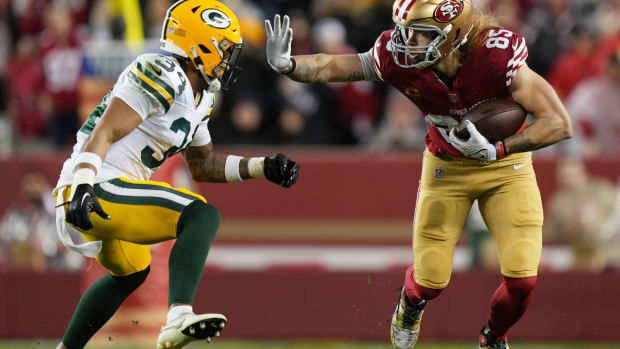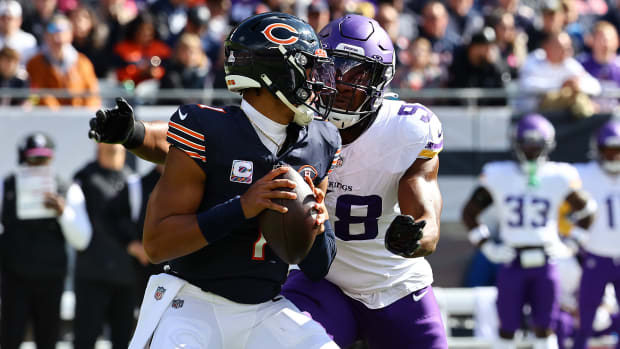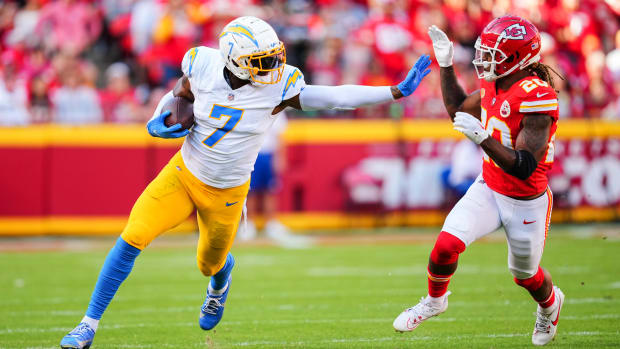How the Chicago Bears Can Avoid Wasting Strong Start
A five-game chunk is more than a sample size.
It's a nice cross-section of the season for the Bears to examine during a few days away while they rest and hope to avoid the COVID-19 warning issued for Lake County this week, where Halas Hall is located.
There are problems to be addressed despite a 4-1 record and they're as obvious as several statistics trending in the wrong direction.
The Running Attack
Part of this is simply misfortune, part is not, and the real issue now is whether they can prevent it from becoming much worse let alone turn it in a positive direction.
Losing James Daniels for the season due to a torn pectoral muscle puts all their offensive plans in jeopardy, and particularly the running game. His ability as a run blocker was never more obvious than the key block he threw to help lock up the win over Atlanta on David Montgomery's 11-yard run around right end.
The Bears are last in the NFL in rushing touchdowns with only the one David Montgomery scored Thursday against Tampa Bay. The Bears are 29th in rushing attempts and 27th in yards, but those two rankings will certainly drop since the rest of the league plays this weekend.
The wheels haven't fallen entirely off Bill Lazor's and Juan Castillo's attempt to turn around the running attack. They're going to need to tighten things up.
The Bears running attack was planned and executed well the first three weeks and they ranked 11th in the league.
They had a running quarterback and the defense had to be more aware of the back-door damage caused by quarterback Mitchell Trubisky's ability to keep the ball on an RPO and take off around end, or take a snap under center and bootleg. The edge rushers couldn't close as fast against the run on the back side. It spread out the defensive front more and made for easier rushing yards.
Now, with Nick Foles playing quarterback, defenses have an easier time defending the run because they don't need to protect the back side as much. Chances for success naturally decline.
The biggest factor causing damage to the running attack, though, is purely luck of schedule.
"The last two weeks, I've said it over and over, these two teams we've faced on the front line and linebackers, they're really good," Bears coach Matt Nagy said.
In successive weeks they've faced two of the top four run defenses in the NFL. This is no excuse for only 63 yards on the ground in two games but they would have been limited nonetheless.
There's every reason to believe they could reverse the trend in their next two games against the Panthers, who rank 21st against the run and 29th in yards allowed per attempt, and the Rams, who are are 18th against the run and 27th in yards per attempt. The Bears won't run into another potent run defense until closing the first half of the season against New Orleans, which is sixth against the run.
So if they can get backup guard Alex Bars fitting into the run-blocking scheme, and run better out of the shotgun with Foles at quarterback, this all flips. Foles isn't going to provide a run threat so they'll have to live without the bootleg action when he's under center. And they don't want him throwing bootleg passes, anyway. He proved he couldn't do it well in the last game on a bad overthrow when Allen Robinson could have taken a short toss for 30 or 40 yards.
Plugging the Middle
Sadly, there is little personnel-wise they can address here to stop the run better. They've lost the chance to sign Damon Harrison as he's now with Seattle. Improvement must come from within.
When John Jenkins recovers from a ligament injury in his hand, they'll be deeper up the middle and probably a little better. However, this type of injury requires more than three weeks to heal fully. A hand injury is more important for players on the defensive front than it might appear, and the Bears found this out last year with Bilal Nichols' injury and the one Leonard Floyd had in 2018. Even after both returned, they struggled for weeks until regaining full use.
Nose tackle has been a real problem without Eddie Goldman, who opted out. It has exposed linebackers Danny Trevathan and Roquan Smith to blockers and made it so runners don't need to cut back into the waiting arms of Akiem Hicks on runs initially made to the left. Runners simply follow the blocking scheme now.
This can only improve by better technique from Bilal Nichols and others at the nose. No one can be the stout force Goldman was.
Stopping the run may occasionally require more aggressive tactics from defensive coordinator Chuck Pagano. Blitzing on run downs or bringing safeties deeper into the box might be necessary. He blitzed defensive backs to stop the run in the second half against Atlanta and it really didn't help much, so he stopped doing it and the Falcons melted down anyway.
Getting the Ball Downfield
This one particular problem continues to plague Nagy's offense more than anything else. If they could solve it, the entire offense might open wide.
The Bears pulled Trubisky and he averaged an anemic 6.5 yards per attempt. They brought in Foles, whose career has fluctuated greatly in this area although he definitely has the arm and will to put it downfield. The result is Foles is averaging a horrifying 6.0 yards per attempt.
Part of this is the lack of a running attack, allowing defenses to choke off downfield passing and run after the catch.
The play-action game with deeper throws enjoyed early against Detroit, New York and Atlanta has disappeared.
The wheel route they ran to David Montgomery for 17 yards in a crucial play Thursday wasn't typical of what they've been able to do and they need more plays like this with Foles adjusting at the line to take advantage of defensive schemes he sees.
Better timing in the passing attack with Foles getting in sync with his receivers now can benefit in tighter coverage, as well.
"There's a lot of areas to improve and we all know that, and that's exciting because I feel like we're putting these pieces together," Foles said. "And it reminds me of some special teams I've been on where the first part of the season, you go through this and then you finally figure out what works and what you want to be and you start rolling."
Finding a solution to this and the other two problems before the decay becomes severe enough to put the Bears among 23% of teams who miss the playoffs after a 4-1 start is the real key.
Twitter: BearDigest@BearsOnMaven




